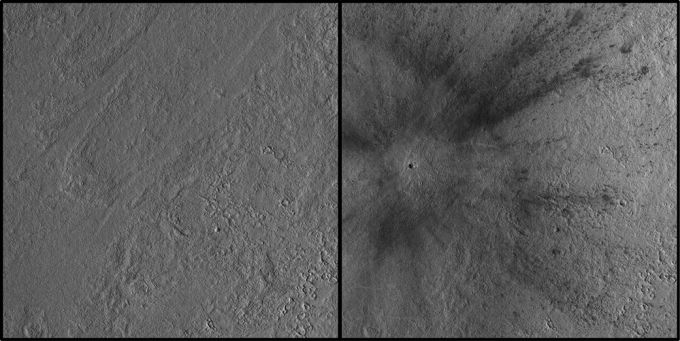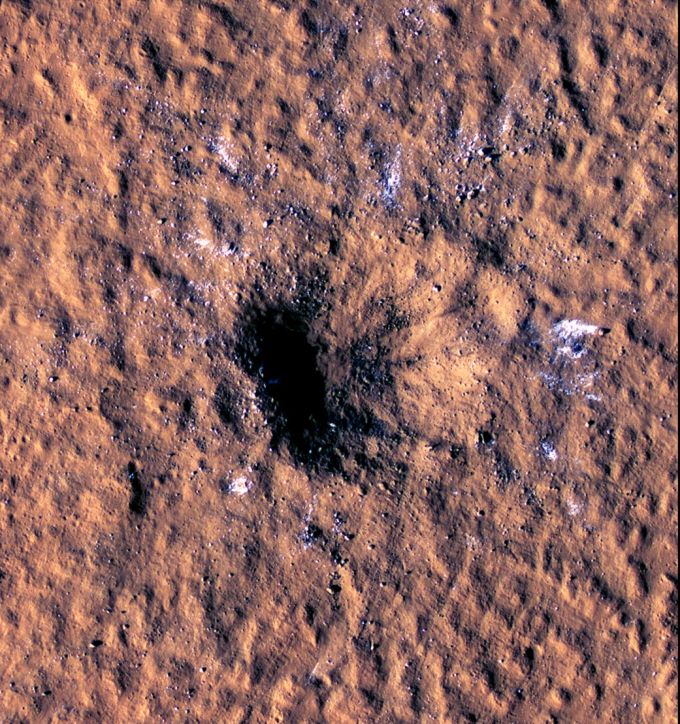Science
New impact crater on Mars uncovered 'hidden' cache of ice – The Weather Network

Tracking down a new meteorite crater on Mars has revealed a potential new resource that could be crucial to NASA’s plans for future human exploration of the Red Planet.
Last Christmas eve, NASA received a special present from space. A small asteroid slammed into the surface of Mars on December 24, 2021. It impacted in a wide flat region of the planet named Amazonis Planitia, located just to the west of the immense Martian volcano, Olympus Mons.
No spacecraft or surface mission witnessed the actual impact as it happened. However, NASA’s InSight lander, a few thousand kilometres away, picked up the seismic waves that radiated out from the impact site. The lander’s sensitive SEIS instrument (Seismic Experiment for Interior Structure) registered the temblor as one of the largest marsquakes it had detected so far.
At the time, the science team didn’t know that it was a meteorite impact.
However, the next time NASA’s Mars Reconnaissance Orbiter flew over where the marsquake originated from, the images it sent back managed to capture the fresh crater the space rock blasted into the surface.
These two images from MRO’s Context Camera show before-and-after views of the location of the meteorite impact on Dec. 24, 2021, in a region of Mars called Amazonis Planitia. Credit: NASA/JPL-Caltech/MSSS.
The crater was measured at around 150 metres wide and more than 20 metres deep! That apparently makes it the largest fresh crater ever imaged by MRO in the 16 years it has been orbiting Mars!
The meteoroid that formed the crater is estimated at being between 5 to 12 metres across. Such a space rock would have shattered in Earth’s atmosphere, possibly scattering meteorites across the surface. However, Mars’ very thin atmosphere posed almost no obstacle to it. Thus, it slammed into the ground at almost full-force.
Even more remarkable than the crater itself is what MRO’s images picked up surrounding it.


In the image shown above, bright white and blue regions stand out against the dusty surface of Amazonis Planitia. Those are wide patches and boulder-sized blocks of water ice, excavated from under the surface by the force of the impact.
“The image of the impact was unlike any I had seen before, with the massive crater, the exposed ice, and the dramatic blast zone preserved in the Martian dust,” Liliya Posiolova, the lead author of the study that located the crater, said in a NASA press release. Posiolova leads the Orbital Science and Operations Group at Malin Space Science Systems. “I couldn’t help but imagine what it must have been like to witness the impact, the atmospheric blast, and debris ejected miles downrange.”
This is apparently the first time we have seen such a deposit of water ice so close to Mars’ equator.
“Subsurface ice will be a vital resource for astronauts, who could use it for a variety of needs, including drinking water, agriculture, and rocket propellant,” NASA said. “Buried ice has never been spotted this close to the Martian equator, which, as the warmest part of Mars, is an appealing location for astronauts.”
Author’s note: In the video that leads off this story, NASA details another meteorite impact on Mars, detected in early September, 2021. According to a report by the space agency last month, this was the first seismic event recorded by InSight confirmed to be from a meteoroid impact. The data examined for this discovery also led to the discovery of three other impacts from InSight’s records, on May 27, 2020, Feb 18, 2021 and Aug 31, 2021.
Science
SpaceX sends 23 Starlink satellites into low-Earth orbit


|
|
April 23 (UPI) — SpaceX launched 23 Starlink satellites into low-Earth orbit Tuesday evening from Space Launch Complex 40 at Cape Canaveral Space Force Station in Florida.
Liftoff occurred at 6:17 EDT with a SpaceX Falcon 9 rocket sending the payload of 23 Starlink satellites into orbit.
The Falcon 9 rocket’s first-stage booster landed on an autonomous drone ship in the Atlantic Ocean after separating from the rocket’s second stage and its payload.
The entire mission was scheduled to take about an hour and 5 minutes to complete from launch to satellite deployment.
The mission was the ninth flight for the first-stage booster that previously completed five Starlink satellite-deployment missions and three other missions.





Science
NASA Celebrates As 1977’s Voyager 1 Phones Home At Last


|
|
Voyager 1 has finally returned usable data to NASA from outside the solar system after five months offline.
Launched in 1977 and now in its 46th year, the probe has been suffering from communication issues since November 14. The same thing also happened in 2022. However, this week, NASA said that engineers were finally able to get usable data about the health and status of its onboard engineering systems.
Slow Work
Fixing Voyager 1 has been slow work. It’s currently over 15 billion miles (24 billion kilometers) from Earth, which means a radio message takes about 22.5 hours to reach it—and the same again to receive an answer.
The problem appears to have been its flight data subsystem, one of one of the spacecraft’s three onboard computers. Its job is to package the science and engineering data before it’s sent to Earth. Since the computer chip that stores its memory and some of its code is broken, engineers had to re-insert that code into a new location.
Next up for engineers at NASA’s Jet Propulsion Laboratory in California is to adjust other parts of the FDS software so Voyager 1 can return to sending science data.
Beyond The ‘Heliopause’
The longest-running and most distant spacecraft in history, Voyager 1, was launched on September 5, 1977, while its twin spacecraft, Voyager 2, was launched a little earlier on August 20, 1977. Voyager 2—now 12 billion miles away and traveling more slowly—continues to operate normally.
Both are now beyond what astronomers call the heliopause—a protective bubble of particles and magnetic fields created by the sun, which is thought to represent the sun’s farthest influence. Voyager 1 got to the heliopause in 2012 and Voyager 2 in 2018.
The Pale Blue Dot is a photograph of Earth taken Feb. 14, 1990, by NASA’s Voyager 1 at a distance of … [+]
NASA/JPL-Caltech
Pale Blue Dot
Since their launch from Cape Canaveral, Florida, aboard Titan-Centaur rockets, Voyager 1 and Voyager 2 have had glittering careers. Both photographed Jupiter and Saturn in 1979 and 1980 before going their separate ways. Voyager 1 could have visited Pluto, but that was sacrificed so scientists could get images of Saturn’s moon, Titan, a maneuver that made it impossible for it to reach any other body in the solar system. Meanwhile, Voyager 2 took slingshots around the planets to also image Uranus in 1986 and Neptune in 1989—the only spacecraft ever to image the two outer planets.
On February 14, 1990, when 3.7 billion miles from Earth, Voyager 1 turned its cameras back towards the sun and took an image that included our planet as “a mote of dust suspended in a sunbeam.” Known as the “Pale Blue Dot,” it’s one of the most famous photos ever taken. It was remastered in 2019.





Science
NASA hears from Voyager 1, the most distant spacecraft from Earth, after months of quiet
|
|
CAPE CANAVERAL, Fla. (AP) – NASA has finally heard back from Voyager 1 again in a way that makes sense.
The most distant spacecraft from Earth stopped sending back understandable data last November. Flight controllers traced the blank communication to a bad computer chip and rearranged the spacecraft’s coding to work around the trouble.
NASA’s Jet Propulsion Laboratory in Southern California declared success after receiving good engineering updates late last week. The team is still working to restore transmission of the science data.
It takes 22 1/2 hours to send a signal to Voyager 1, more than 15 billion miles (24 billion kilometers) away in interstellar space. The signal travel time is double that for a round trip.
Contact was never lost, rather it was like making a phone call where you can’t hear the person on the other end, a JPL spokeswoman said Tuesday.
Launched in 1977 to study Jupiter and Saturn, Voyager 1 has been exploring interstellar space – the space between star systems – since 2012. Its twin, Voyager 2, is 12.6 billion miles (20 billion kilometers) away and still working fine.





-



 Health14 hours ago
Health14 hours agoRemnants of bird flu virus found in pasteurized milk, FDA says
-
Art20 hours ago
Mayor's youth advisory council seeks submissions for art gala – SooToday
-



 Health18 hours ago
Health18 hours agoBird flu virus found in grocery milk as officials say supply still safe
-



 Investment19 hours ago
Investment19 hours agoTaxes should not wag the tail of the investment dog, but that’s what Trudeau wants
-
News19 hours ago
Peel police chief met Sri Lankan officer a court says ‘participated’ in torture – Global News
-



 Science23 hours ago
Science23 hours agoiN PHOTOS: Nature lovers celebrate flora, fauna for Earth Day in Kamloops, Okanagan | iNFOnews | Thompson-Okanagan's News Source – iNFOnews
-
Media14 hours ago
Vaughn Palmer: B.C. premier gives social media giants another chance
-
Art20 hours ago
An exhibition with a cause: Montreal's 'Art by the Water' celebrates 15 years – CityNews Montreal




